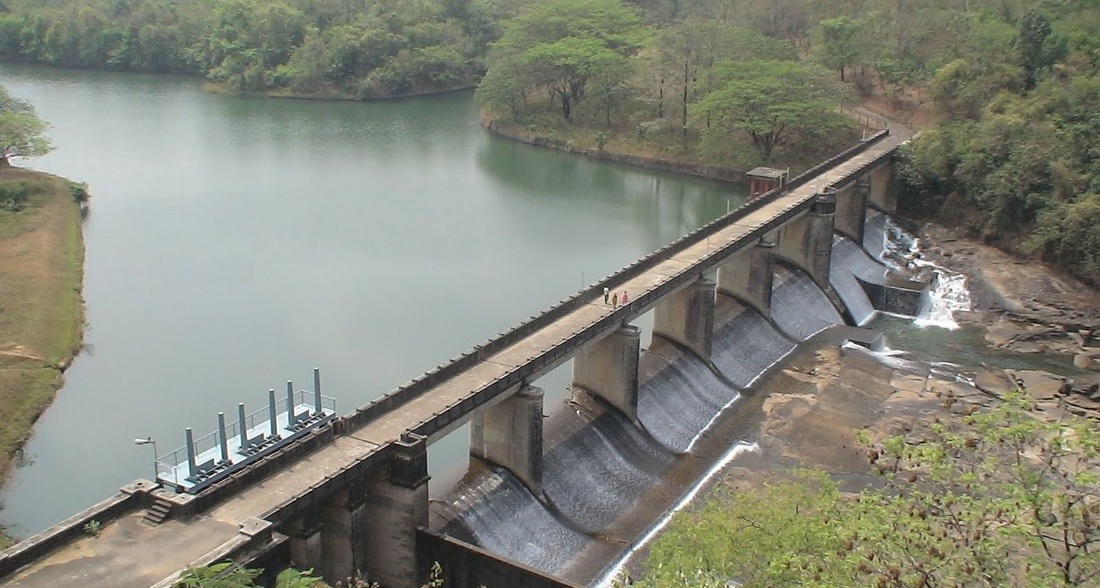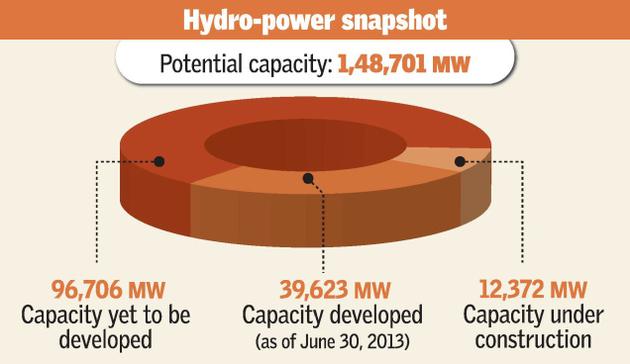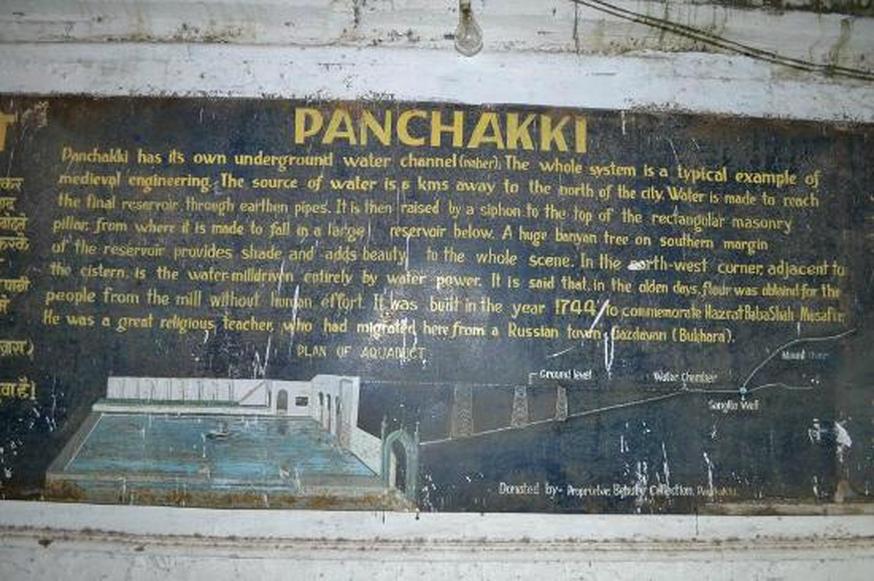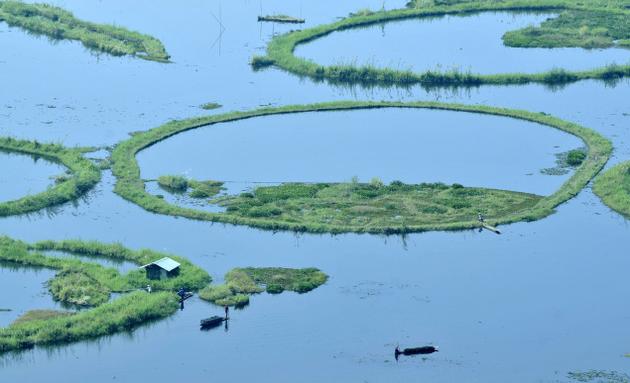What is Hydro Power?
The Word “hydro” means water thus Hydro Power means using the power of water beneficially. The idea of using water for power generation goes back thousands of years. In ancient times some smart guy discovered that the laws of Gravity combined with the weight of falling water were used to move a wheel, technically making the first “engine”.
This Water-Engine was used in ancient times to do exactly the same work that today we do with Petrol Engines and motors - to drive different kinds of mills as in gristmills, hullers, sawmills, ship mills, stamp mills, steel mills, sugar mills, and tide mills which all worked on an industrial scale. These were later abandoned when petrol and electric engines were developed due to their smaller size and portability.
Earlier we used to get the work done for free now we have to pay for it by way of fuel. Obviously the engine was not portable and could work only in places that have streams of water passing through.
Earlier we used to get the work done for free now we have to pay for it by way of fuel. Obviously the engine was not portable and could work only in places that have streams of water passing through.
A hydropower plant is basically an oversized water wheel. Such water raising wheels was used in ancient India to provide Irrigation water for crops. It was also used to grind wheat. One such device called “Panchakki” still can be seen in Aurangabad, India. Stepwells, viaducts many types of storage and irrigation tanks in ancient India and the existence of water tanks chambers and in the Indus Valley civilisation is proof that people depended on the water wheel to grind wheat and lift water for agriculture.
Properties of water based on Indian Astrology:
- “While fire cannot be contained, it disappears if you totally enclose it, and air expands to fill any container, water is more limited and keeps it volume, and has a level.
- While fire cannot destroy the earth, water can.
- Water is the universal solvent that can dissolve things.
- Water can rise high with the help of air, but generally doesn't move upwards.
- Water is extremely powerful, and will always find its own level.
- If water is artificially constrained at a high level, it will eventually break free, but then it will fall. Water is impressionable and reflective.
- You technically cannot landfill water. You fill one side of water with sand the other part of the sand will go under water”
Water is surprisingly heavy and its weight and immerse ability can be destructive! A typical bathtub holds 40 gallons or so of water. That is 330 pounds. A cubic yard of it, filling what at first glance seems a modest volume of 3 feet by 3 feet by 3 feet, weighs nearly 1,700 pounds, as much as the Small Car.
Worldwide, hydropower plants produce about 24 percent of the world's electricity and supply more than 1 billion people with power. The world's hydropower plants output a combined total of 675,000 megawatts, the energy equivalent of 3.6 billion barrels of oil, according to the National Renewable Energy Laboratory. There are more than 2,000 hydropower plants operating in the United States, making hydropower the country's largest renewable energy source.
Worldwide, hydropower plants produce about 24 percent of the world's electricity and supply more than 1 billion people with power. The world's hydropower plants output a combined total of 675,000 megawatts, the energy equivalent of 3.6 billion barrels of oil, according to the National Renewable Energy Laboratory. There are more than 2,000 hydropower plants operating in the United States, making hydropower the country's largest renewable energy source.
See below video of how a Panchakki (pani-chakki) functions.
In this system of power generation, the potential of the water falling under gravitational force is utilised to rotate a turbine which again is coupled to a Generator, leading to generation of electricity. It is the simplest and most widely used form of renewable energy in the world.
Hydropower depends upon the laws of Electricity and the theory that driving an induction motor at higher than normal speed generates electricity. Thus we the water should not only turn the wheel but it should be kept revolving, constantly, above a certain speed.
Hydropower depends upon the laws of Electricity and the theory that driving an induction motor at higher than normal speed generates electricity. Thus we the water should not only turn the wheel but it should be kept revolving, constantly, above a certain speed.
Advantages of hydro-power:
- Anywhere rain falls, there will be rivers.
- Thus Countries like India with higher level of Rainfall can benefit a lot from Hydro Power. It is a natural advantage. Meghalaya in India receives the most rainfall in the world. It has a potential of generating nearly 3,000 MW of HydroElectricity. The Konkan coast right up to Kerala also receives very heavy rain in Monsoon. This combined with the constantly melting snow in Himalayas makes India have the most Water (fresh water) to Land ratio in the World. If India is having a drinking water problem it is only because of the corruption & negligence in the government.
- If a particular section of river has the right terrain to form a reservoir, it may be suitable for dam construction.
- No fossil fuels are required to produce the electricity, and the earth's hydrologic cycle naturally replenishes the "fuel" supply.
- Absolutely no pollution is released into the atmosphere and no waste that requires special containment is produced.
- Since "water is a naturally recurring domestic product and is not subject to the whims of foreign suppliers," there is no worry of unstable prices, transportation issues, production strikes, or other national security issues.
- Multiple turbines can be moved from the same stream of water.
- The dams will increase the underground water table in the areas surrounding not only of the dams but also the areas surrounding the channels through which the tail water flows.
 Cost Vs Benefits
Cost Vs Benefits
Disadvantages of hydro-power:
It has only one disadvantage - that the setting up of the Dam swallows up that much green patch of earth. Most of the area surrounding rivers are green, have thick forest and several tribes live around the rivers. What benefit do these tribals get once they are moved to a area that is unfamiliar to them? do they get free Electricity (which was developed on their house) for life? I believe the displaced should get not only a well built house but also free water and electricity for life.
It has only one disadvantage - that the setting up of the Dam swallows up that much green patch of earth. Most of the area surrounding rivers are green, have thick forest and several tribes live around the rivers. What benefit do these tribals get once they are moved to a area that is unfamiliar to them? do they get free Electricity (which was developed on their house) for life? I believe the displaced should get not only a well built house but also free water and electricity for life.
It is well known that hydroelectric power has a large number of impacts on the environment. Flooding a large area of land where water is to be stored not just takes up large amounts of land it also poses a threat to the natural wildlife living in the area, as well as native villages and people. Flooding of large areas of land can also be a good breeding place for mosquitoes; this can cause an epidemic of mosquito born diseases such as malaria and dengue fever (Cassedy & Edward 2000, p.138). As well as these problems upstream, downstream the water coming out of the plant can contain low dissolved oxygen which can also be harmful to wildlife and people (L.S.A. Economics of Hydropower and the Environment, August 2003). The most important environmental risk that these power plants pose is the impact on migrating fish, which prevents them from swimming upstream.
To solve this problem things like lifts and elevators have to be installed to help he fish get past the dams. (Wind and Hydropower Technologies Program 2005). As well as environmental hazards, a question of financial and political issues arises due to the construction of such large projects. Questions such as the construction expense of these multibillion dollar projects, which is consequently high. These hydro projects must operate for long periods of time before commencing to make a profit. If the river that supplies the hydroelectric power plants flows into two or more countries then legal disputes arise about the ownership of said river. Building a dam can reduce the amounts of water in the neighbouring countries, in some cases this may lead to a political conflict between these countries (IEA 2005).
To solve this problem things like lifts and elevators have to be installed to help he fish get past the dams. (Wind and Hydropower Technologies Program 2005). As well as environmental hazards, a question of financial and political issues arises due to the construction of such large projects. Questions such as the construction expense of these multibillion dollar projects, which is consequently high. These hydro projects must operate for long periods of time before commencing to make a profit. If the river that supplies the hydroelectric power plants flows into two or more countries then legal disputes arise about the ownership of said river. Building a dam can reduce the amounts of water in the neighbouring countries, in some cases this may lead to a political conflict between these countries (IEA 2005).
Different types of wheel position were used depending upon the topography of the area or the requirement, like:
1. Horizontal wheel has a vertical axis, commonly called a tub wheel or Norse mill, the horizontal wheel is essentially a very primitive and inefficient form of the modern turbine. It is usually mounted inside a mill building below the working floor. A jet of water is directed on to the paddles of the water wheel, causing them to turn; water exits beneath the wheel, generally through the center. This is a simple system, usually used without gearing so that the vertical axle of the water wheel becomes the drive spindle of the mill.
1. Horizontal wheel has a vertical axis, commonly called a tub wheel or Norse mill, the horizontal wheel is essentially a very primitive and inefficient form of the modern turbine. It is usually mounted inside a mill building below the working floor. A jet of water is directed on to the paddles of the water wheel, causing them to turn; water exits beneath the wheel, generally through the center. This is a simple system, usually used without gearing so that the vertical axle of the water wheel becomes the drive spindle of the mill.
2. Vertical Wheel had horizontal axis and there were 3 type of vertical wheel depending upon where the water hit the wheel:

a) Undershot wheel
An undershot wheel (also called a stream wheel[50]) is a vertically mounted water wheel that is rotated by water striking paddles or blades at the bottom of the wheel. The name undershot comes from this striking at the bottom of the wheel. This type of water wheel is the oldest type of wheel.
The advantages of undershot wheels are that they are somewhat cheaper and simpler to build, and have less of an environmental impact—as they do not constitute a major change of the river. Their disadvantages are—as mentioned before—less efficiency, which means that they generate less power and can only be used where the flow rate is sufficient to provide torque.
Undershot wheels gain no advantage from head. They are most suited to shallow streams in flat country.Undershot wheels are also well suited to installation on floating platforms. They were sometimes mounted immediately downstream from bridges where the flow restriction of arched bridge piers increased the speed of the current.
An undershot wheel (also called a stream wheel[50]) is a vertically mounted water wheel that is rotated by water striking paddles or blades at the bottom of the wheel. The name undershot comes from this striking at the bottom of the wheel. This type of water wheel is the oldest type of wheel.
The advantages of undershot wheels are that they are somewhat cheaper and simpler to build, and have less of an environmental impact—as they do not constitute a major change of the river. Their disadvantages are—as mentioned before—less efficiency, which means that they generate less power and can only be used where the flow rate is sufficient to provide torque.
Undershot wheels gain no advantage from head. They are most suited to shallow streams in flat country.Undershot wheels are also well suited to installation on floating platforms. They were sometimes mounted immediately downstream from bridges where the flow restriction of arched bridge piers increased the speed of the current.
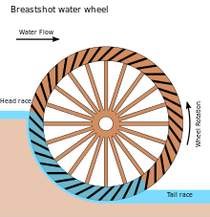
b) Breastshot wheel
A vertically mounted water wheel that is rotated by falling water striking buckets near the center of the wheel's edge, or just above it, is said to be breastshot. Breastshot wheels are the most common type in the United States of America and are said to have powered the American industrial revolution.
Breastshot wheels are less efficient than overshot wheels, are more efficient than undershot wheels, and are not backshot. The individual blades of a breastshot wheel are actually buckets, as are those of most overshot wheels, and not simple paddles like those of most undershot wheels. A breastshot wheel requires a good trash rack and typically has a masonry "apron" closely conforming to the wheel face, which helps contain the water in the buckets as they progress downwards. Breastshot wheels are preferred for steady, high-volume flows such as are found on the fall line of the North American East Coast.
A vertically mounted water wheel that is rotated by falling water striking buckets near the center of the wheel's edge, or just above it, is said to be breastshot. Breastshot wheels are the most common type in the United States of America and are said to have powered the American industrial revolution.
Breastshot wheels are less efficient than overshot wheels, are more efficient than undershot wheels, and are not backshot. The individual blades of a breastshot wheel are actually buckets, as are those of most overshot wheels, and not simple paddles like those of most undershot wheels. A breastshot wheel requires a good trash rack and typically has a masonry "apron" closely conforming to the wheel face, which helps contain the water in the buckets as they progress downwards. Breastshot wheels are preferred for steady, high-volume flows such as are found on the fall line of the North American East Coast.

c) Overshot wheel
A vertically mounted water wheel that is rotated by falling water striking paddles, blades or buckets near the top of the wheel is said to be overshot. In true overshot wheels the water passes over the top of the wheel, but the term is sometimes applied to backshot or pitchback wheels where the water goes down behind the water wheel.
A typical overshot wheel has the water channeled to the wheel at the top and slightly beyond the axle. The water collects in the buckets on that side of the wheel, making it heavier than the other "empty" side. The weight turns the wheel, and the water flows out into the tail-water when the wheel rotates enough to invert the buckets. The overshot design can use all of the water flow for power (unless there is a leak) and does not require rapid flow.
Unlike undershot wheels, overshot wheels gain a double advantage from gravity. Not only is the momentum of the flowing water partially transferred to the wheel, the weight of the water descending in the wheel's buckets also imparts additional energy. The mechanical power derived from an overshot wheel is determined by the wheel's physical size and the available head, so they are ideally suited to hilly or mountainous country.
A vertically mounted water wheel that is rotated by falling water striking paddles, blades or buckets near the top of the wheel is said to be overshot. In true overshot wheels the water passes over the top of the wheel, but the term is sometimes applied to backshot or pitchback wheels where the water goes down behind the water wheel.
A typical overshot wheel has the water channeled to the wheel at the top and slightly beyond the axle. The water collects in the buckets on that side of the wheel, making it heavier than the other "empty" side. The weight turns the wheel, and the water flows out into the tail-water when the wheel rotates enough to invert the buckets. The overshot design can use all of the water flow for power (unless there is a leak) and does not require rapid flow.
Unlike undershot wheels, overshot wheels gain a double advantage from gravity. Not only is the momentum of the flowing water partially transferred to the wheel, the weight of the water descending in the wheel's buckets also imparts additional energy. The mechanical power derived from an overshot wheel is determined by the wheel's physical size and the available head, so they are ideally suited to hilly or mountainous country.
English civil engineer John Smeaton in the 18th century calculated that on average the percent of the energy in the flow of water is as under:
- Undershot wheel uses 22%,
- Overshot wheel uses 63%
A Waterwheel could be undershot, backshot, and overshot all at once using two sources of water. This allows the speed of the wheel to be controlled.

Reversible wheel
A special type of overshot wheel is the reversible water wheel. This has two sets of blades or buckets running in opposite directions, so that it can turn in either direction depending on which side the water is directed. Reversible wheels were used in mining industry in order to power various means of ore conveyance. By changing the direction of the wheel, barrels or baskets of ore could be lifted up or lowered down a shaft. As a rule there was also a cable drum or a chain basket on the axle of the wheel. It was also essential that the wheel had braking equipment in order to be able to stop the wheel.
A special type of overshot wheel is the reversible water wheel. This has two sets of blades or buckets running in opposite directions, so that it can turn in either direction depending on which side the water is directed. Reversible wheels were used in mining industry in order to power various means of ore conveyance. By changing the direction of the wheel, barrels or baskets of ore could be lifted up or lowered down a shaft. As a rule there was also a cable drum or a chain basket on the axle of the wheel. It was also essential that the wheel had braking equipment in order to be able to stop the wheel.
Types of Hydro Plants
Points 1 & 2 we can ignore as they are under the capability of State or a company.
But Point no. 3 is directly linked to us. Where ever we see water falling from a height or running streams of water just remember we can have electricity there. Thus running water is equivalent to electricity.
- Mega Hydro Power Plant - Provide Electricity for a particular region/province/state.
- Mini Hydro Power Plant - Provide Electricity for a particular factory/industry.
- Micro Hydro Power Plant - Provide Electricity for a house.
Points 1 & 2 we can ignore as they are under the capability of State or a company.
But Point no. 3 is directly linked to us. Where ever we see water falling from a height or running streams of water just remember we can have electricity there. Thus running water is equivalent to electricity.
What are the benefits of using micro-hydro?
Most people associate hydro power with mega installations such as the three gorges dam in China. Yet, there is great potential for small, decentralized hydro installations on rivers and streams. Old mills present perfect opportunities to restore part of our industrial and rural heritage and house modern, clean power generation projects.
Most people associate hydro power with mega installations such as the three gorges dam in China. Yet, there is great potential for small, decentralized hydro installations on rivers and streams. Old mills present perfect opportunities to restore part of our industrial and rural heritage and house modern, clean power generation projects.
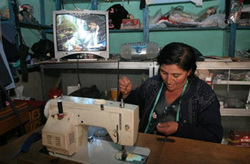
In remote areas, micro-hydro schemes can bring electricity for the first time to whole communities. This provides lighting, TV and communications for homes, schools, clinics and community buildings. The electrical power from micro-hydro also is sufficient to run machinery and refrigerators, thus supporting small businesses as well as homes.
On average, project implementation for micro hydro is around 2-4 months, which is about 2-3 times longer than for solar projects. On the other hand though, the lifetime of a small hydro installation is approximately twice as long as for solar.
Two benefits from micro-hydro in the village of Conchan,
Peru- running a sewing business and watching TV
On average, project implementation for micro hydro is around 2-4 months, which is about 2-3 times longer than for solar projects. On the other hand though, the lifetime of a small hydro installation is approximately twice as long as for solar.
Two benefits from micro-hydro in the village of Conchan,
Peru- running a sewing business and watching TV
 Grinding maize using water mill in Nepal
Grinding maize using water mill in Nepal
An important benefit of micro hydro is the predictability of electricity production. Solar only produces electricity during daylight hours. Rivers always flow. Hence, so-called baseload can be guaranteed making it an attractive piece of the energy jigsaw. Variations in power production of small hydro are mainly seasonal. When rainfall is heavy, more hydro power is generated. Another interesting aspect of micro hydro is that, where appropriate, you can store some of the potential energy of the river overnight when there is less demand and release it during peak hours.

